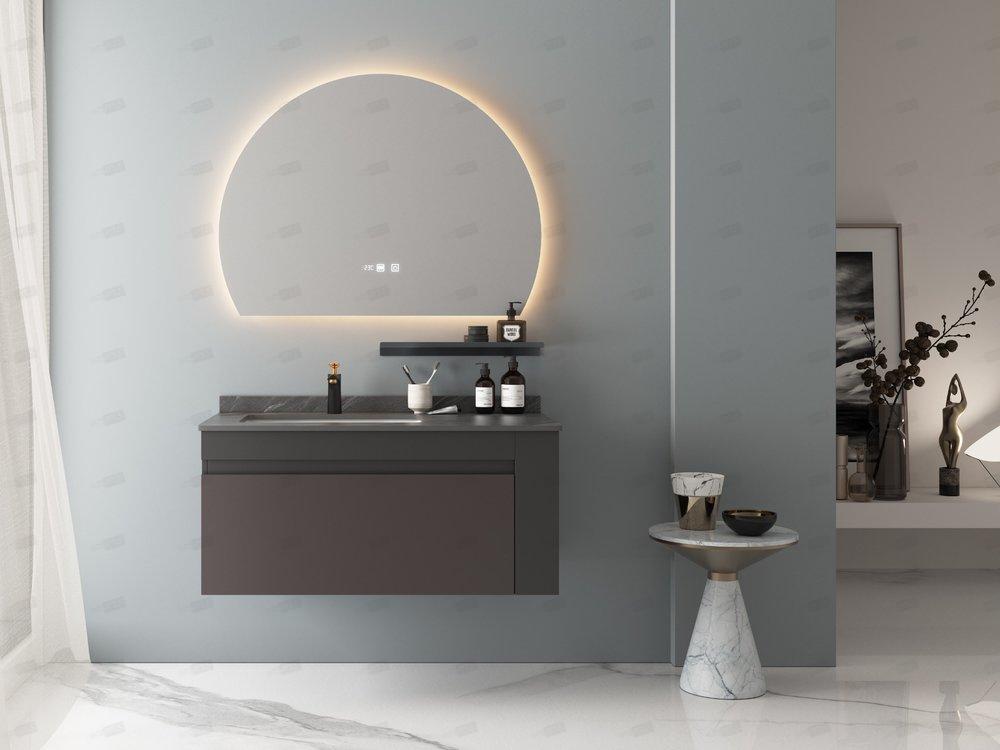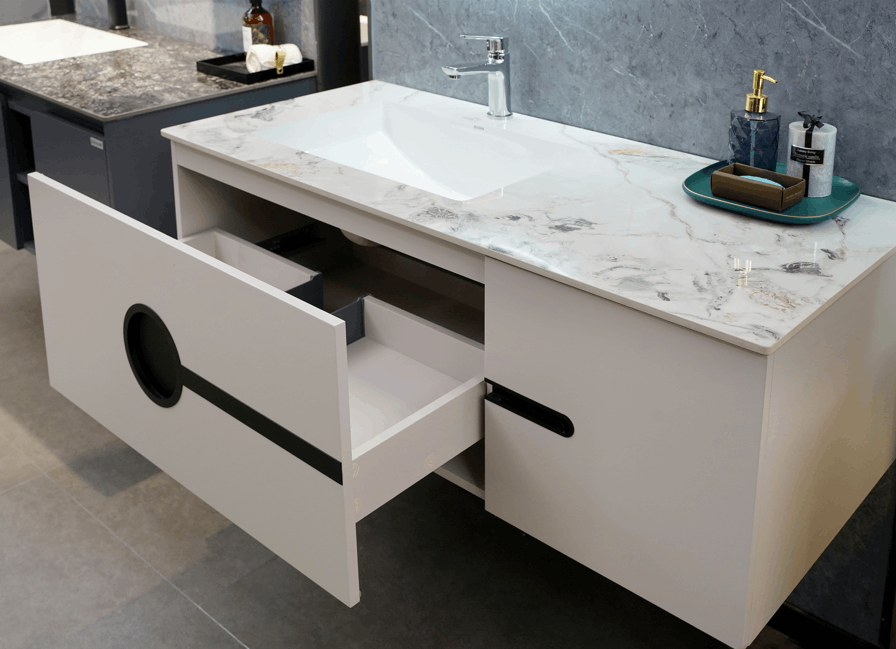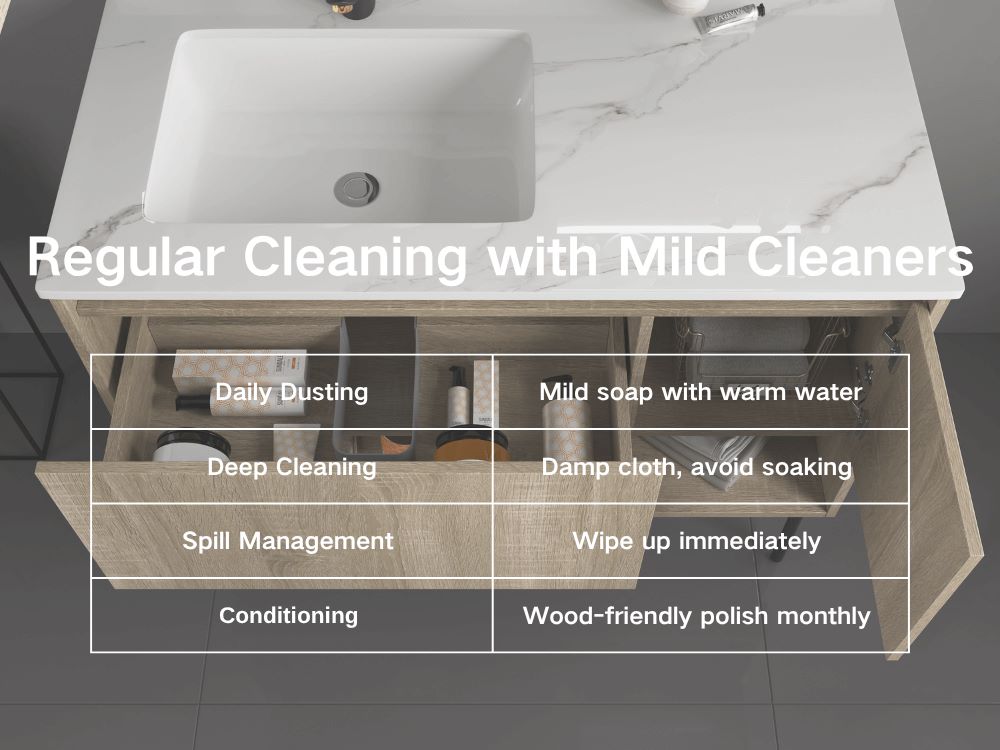Choosing the right wood for your bathroom vanity can elevate style, enhance durability, and guarantee longevity. From the rich grains of walnut to the sleek finish of engineered options, each wood type offers unique benefits. With moisture resistance and aesthetic appeal in mind, you’ll want to contemplate various factors before making your decision. Are you curious about which wood stands up best against humidity and wear? The answer might surprise you.

When choosing wood for your bathroom vanity, you’ll encounter a variety of stunning options like solid teak, walnut, ash, cherry, and maple.
Each wood type brings its own unique charm and durability, influencing both the aesthetic and functionality of your space.
Therefore, for the best wood cabinets, consider the following types of wood:
Solid teak wood stands out as a premier choice for bathroom vanities, thanks to its remarkable natural properties.
Known as the best wood for bathroom vanity, solid teak offers exceptional resistance to water and moisture, thanks to its inherent oils. This durability assures that your vanity withstands the humid environment of a bathroom without warping or decaying.
Plus, solid teak wood resists scratches and dents, making it perfect for everyday use. Its rich, golden hue adds a touch of luxury, enhancing your bathroom’s aesthetic.
While it may be pricier and in shorter supply, investing in solid teak wood guarantees a long-lasting, stylish solution that commands attention and control in your space.
Walnut, a luxurious hardwood, brings an elegant touch to bathroom vanities with its rich, dark tones and striking grain patterns. This wood not only enhances aesthetics but also offers durability and resilience against daily wear.
When considering walnut for your bathroom vanity, keep these key points in mind:
Embrace walnut’s exquisite beauty and strength to create a bathroom vanity that commands attention while providing functionality and longevity.
Ash wood, renowned for its strength and versatility, makes an excellent choice for bathroom vanities. It’s not just about aesthetics; ash offers durability and a beautiful grain that can elevate your space.
If you’re seeking the best wood for bathroom cabinet construction, ash provides natural resistance to warping, ensuring longevity in humid environments. Its light color can easily be stained or finished, making it a flexible option for a wood for bathroom vanity top.
You’ll appreciate how ash adapts to various styles, from modern to rustic. Plus, its affordability allows you to create a stunning centerpiece without breaking the bank.
When contemplating wood for your bathroom vanity, cherry stands out with its rich color and enchanting grain patterns. This hardwood's elegance adds sophistication to any space, making it a popular choice for a cherry bathroom vanity.
Here are some key features to contemplate:
Choosing a cherry bathroom vanity over alternatives like an oak bathroom vanity allows you to enjoy a warm, inviting atmosphere that evolves gracefully throughout the years.
However, your decision reflects your style and control over your bathroom's aesthetic.
Maple wood, with its stunning light blonde hue and smooth grain, makes an exceptional choice for bathroom vanities. Its dense composition offers durability, making it ideal for humid environments. While a maple bathroom vanity can be a budget-friendly option compared to a teak bathroom vanity, it still delivers an elegant look.
Choosing a maple vanity can bring a fresh, vibrant style to your space while ensuring longevity and ease of care.
Although oak is often celebrated for its classic beauty and resilience, it’s the combination of durability and versatility that makes it a top choice for bathroom vanities. If you’re contemplating an IKEA bathroom vanity, oak is an excellent option due to its strength and timeless appeal.
Here are some key benefits of choosing oak:
Incorporating oak into your bathroom design empowers you to create a sophisticated space that stands the test of time.
If you're exploring wood options for your bathroom vanity, birch deserves your attention. This attractive wood boasts a creamy white to reddish-brown hue, making it versatile for various styles.
Birch's fine grain offers a smooth finish that enhances its natural beauty, yet it can be challenging to stain due to its density. While it's less durable than hardwoods like oak or maple, birch's warp resistance is commendable, especially in humid environments.
It’s budget-friendly, allowing you to create a stunning vanity without breaking the bank. Just remember to maintain it by promptly cleaning spills and dusting regularly to keep it looking fresh.
With birch, you can achieve an elegant and practical design effortlessly.
Bamboo offers a unique blend of sustainability and style that sets it apart from traditional woods.
This eco-friendly option isn't only visually appealing but also incredibly durable, making it a smart choice for moisture-prone areas.
Bamboo's eco-friendly charm opens the door to another luxurious option for your bathroom vanity: mahogany.
This exquisite wood, with its deep reddish-brown hue and fine grain, radiates elegance while providing exceptional durability. Mahogany's natural resistance to moisture makes it a strong contender for humid environments, ensuring your vanity withstands the test of time.
Its rich color can be enhanced with stains, allowing you to achieve a unique look that complements your style. However, keep in mind that mahogany can be on the pricier side; investing in this stunning wood can elevate your bathroom’s aesthetic and longevity.
With proper care, including regular dusting and conditioning, your mahogany vanity will remain a centerpiece of luxury for years to come.
Plywood is a versatile option for bathroom vanities that combines practicality with durability. When you choose plywood, you’re opting for a material that stands up well to moisture and daily use. It’s engineered for strength and stability, making it less susceptible to warping compared to solid wood.
Here are a few key advantages:
With plywood, you gain control over your design without sacrificing durability or functionality, ensuring your vanity remains beautiful and practical for years to come.

Although solid wood often takes the spotlight, Medium Density Fiberboard (MDF) offers a compelling alternative for bathroom vanities. MDF is engineered for durability and moisture resistance, making it an excellent choice for humid environments. It’s cost-effective and easily painted, allowing you to achieve any look you desire. However, keep in mind that while it’s great for aesthetics, MDF can be difficult to repair if damaged.
Choosing MDF gives you control over design without breaking the bank, making it a smart choice for your bathroom vanity.
When you choose a wooden bathroom vanity, you’re inviting a warm, natural feel into your space that instantly elevates its charm.
Plus, the customization options are endless, allowing you to create a look that truly reflects your style.
Not to mention, opting for sustainably sourced wood makes your choice eco-friendly, contributing to a healthier planet while enhancing your home.
Choosing a wooden bathroom vanity brings a warm, natural feeling to your space that synthetic materials simply can’t replicate. This organic touch enhances not only the aesthetic but also your overall experience in the bathroom.
Consider these benefits of a wooden vanity:
Wooden bathroom vanities not only offer a natural beauty but also provide remarkable opportunities for customization that enhance your personal style.
You can easily choose from various wood types, stains, and finishes to create a look that reflects your taste. Want a rustic charm? Go for a distressed finish on oak. Prefer a sleek modern vibe? A glossy walnut finish might be perfect.
You can also add unique hardware, like vintage knobs or contemporary pulls, to elevate your design further. Plus, custom carving or detailing can transform a standard piece into something uniquely yours.
With wooden vanities, you have the power to craft a space that’s not just functional but also a true reflection of who you are.
Opting for a wooden bathroom vanity not only enhances your space's aesthetic but also contributes positively to the environment. By choosing sustainable wood options, you can enjoy a beautiful vanity while making eco-conscious choices.
Here are some benefits of wooden vanities:
These choices not only align with your values but also elevate your bathroom’s ambiance.
When choosing wood for your bathroom vanity, you'll want to take into account moisture resistance, durability, and maintenance needs to guarantee longevity.
Aesthetic appeal and customization options can elevate your space, while being mindful of environmental impact adds a layer of responsibility to your choice.
Balancing these factors will help you create a beautiful and functional vanity that stands the test of time.
Considering the high humidity levels typical in bathrooms, moisture resistance emerges as a critical factor in selecting wood for your vanity. You want to guarantee your choice can withstand the steam and splashes that bathrooms often face.
While selecting the right wood for your bathroom vanity, durability and maintenance play an essential role in ensuring your investment lasts.
You’ll want to take into account woods like oak and teak, which are naturally resistant to moisture and wear. Hardwoods generally withstand daily use better than softer varieties.
Maintenance is equally significant; some woods require minimal care, while others need regular oiling or conditioning. Be mindful of cleaning methods—use a damp cloth and mild soap to avoid damaging finishes.
Establish good ventilation to combat humidity and protect your vanity.
A stunning bathroom vanity can transform your space, making aesthetic appeal and customization essential factors in your wood selection.
When choosing the wood, consider the following:
When selecting wood for your bathroom vanity, it’s crucial to think about the environmental impact and sustainability of your choices.
Prioritize sustainably sourced wood, like FSC-certified materials, which support responsible forestry practices. This guarantees that your vanity not only looks great but also contributes to ecological balance.
Reclaimed wood offers a unique, eco-friendly alternative, reducing demand for new resources while adding character to your space.
Consider the lifecycle of the wood and its carbon footprint; every choice you make can influence the planet.
By opting for environmentally conscious options, you express your commitment to sustainability while enhancing your bathroom's design.
Control your environment and make a statement with your responsible wood selections.
When installing your bathroom vanity, a solid foundation is key, so make certain to follow the manufacturer's guidelines for a secure fit.
Regular cleaning with mild cleaners keeps the wood looking fresh, while avoiding excessive moisture helps prevent warping and damage.
Don’t forget to stock up on essential maintenance materials, like wood polish and sealants, to guarantee your vanity stays beautiful for years to come.
Although selecting the right wood type for your bathroom vanity is essential, the installation process can greatly impact its longevity and performance.
To guarantee a seamless installation, follow these key steps:
Once your bathroom vanity is securely installed and ready for use, maintaining its beauty and integrity through regular cleaning is key. Utilize mild cleaners to keep your vanity looking pristine without damaging the wood. Here’s a quick reference guide for your cleaning routine:

To protect your bathroom vanity from the damaging effects of excessive moisture, it’s essential to implement a few strategic measures during both installation and maintenance.
Start by ensuring proper ventilation; an exhaust fan will effectively reduce humidity levels.
Next, always wipe up any spills immediately to prevent water damage.
Finally, consider applying a high-quality sealant to enhance the wood's natural moisture resistance.
Selecting the right materials is essential for both installation and ongoing upkeep, if you want to maintain your bathroom vanity,
Opt for solid woods like teak or oak, which offer durability and natural moisture resistance. Plywood and medium-density fiberboard (MDF) can be cost-effective alternatives, but make sure they're high-density to withstand humidity.
Use water-resistant sealants or finishes for added protection against moisture damage. For cleaning, choose soft, damp cloths and mild soaps, avoiding harsh chemicals that can harm finishes.
Regularly dusting and conditioning with wood-friendly polish will keep your vanity looking pristine.
Bathroom vanities come in a stunning array of styles and designs, each offering a unique blend of functionality and aesthetic appeal.
Here are three popular designs to inspire your choice:
When it comes to choosing a wooden vanity, understanding the costs involved is key to staying within your budget.
You’ll find that solid wood options can be pricier than other materials, but they often offer superior durability and aesthetic appeal.
Although choosing the right wood for your vanity can elevate your bathroom's aesthetic, budgeting for it requires careful consideration.
Start by determining your budget range and stick to it. Here are some tips to help you navigate costs effectively:
Choosing a wooden vanity can be an investment, but understanding how it stacks up against other materials helps in making an informed decision.
While solid wood options like oak and walnut can be pricier due to their durability and aesthetic appeal, alternatives like plywood and MDF often come at a lower cost.
However, these cheaper materials may lack the longevity and charm of real wood. If you're on a budget, maple or birch can provide a balance of affordability and style.
Ultimately, consider the long-term value of your investment; a quality wooden vanity can elevate your bathroom’s look and function, potentially saving you money on repairs and replacements down the road.
There is no such thing as solid wood that is 100% waterproof and rot proof, but of course there are certainly some that are better in comparison.
Certain wood types can withstand moisture better than others, ensuring longevity and maintaining aesthetics. Teak, naturally rich in oils that repel water, making it ideal for humid environments.
Solid wood is usually a superior choice for bathroom cabinets, but it is important to ensure proper ventilation to minimize moisture buildup. Additionally, regularly wipe away any standing water from your cabinet to help protect the wood and prolong its life.
Don’t overlook the importance of selecting a water-resistant wood to keep your vanity looking pristine for years to come.
You'll discover a world of possibilities to truly make your own bathroom cabinet. From choosing the wood type to selecting the finish, you can tailor every aspect to fit your vision.
Want a sleek, modern look? A glossy white finish on maple might be perfect. Prefer rustic charm? Opt for a rich stain on oak or hickory.
You can also personalize hardware, selecting knobs and pulls that reflect your style—think contemporary metals or vintage brass.
Furthermore, don’t forget about sink options; vessel sinks can add a striking focal point. Embrace your creativity, and design a vanity that not only meets your needs but also resonates with your aesthetic preferences.
When it comes to enhancing your wood vanity's beauty, think outside the box! A good polish, strategic lighting, and thoughtful decor can bring out its natural charm, turning your bathroom into a stunning oasis.
Consider using reclaimed wood or FSC-certified options for your bathroom vanity. These eco-friendly choices not only enhance sustainability but also add unique character and charm, ensuring your space stands out beautifully while being environmentally conscious.
For wooden bathroom cabinets, consider finishes like polyurethane for durability, or water-based varnish for a low odor. Stains enhance color, while sealants protect against moisture. Choose wisely to maintain beauty and longevity in your space.
To prevent wood from warping in humid environments, use exhaust fans, promptly wipe up spills, apply a moisture-repellent sealant, and maintain good ventilation. Regular care keeps your wood looking great and lasting longer.
Mixing different wood types in your bathroom design can create a stunning contrast, blending warmth with elegance. Just guarantee you balance colors and grains, maintaining harmony while embracing unique textures for a personalized, inviting space.
In the quest for the perfect bathroom vanity, you might think choosing wood is straightforward—just pick what looks good, right? Ironically, it's the hidden qualities like moisture resistance and durability that truly matter. So, while you’re admiring that stunning walnut finish, remember: it’s not just about beauty; it’s about longevity and functionality. Make your choice wisely, and your vanity will not only command your design but also stand strong against the dampness of time.
UNCOVER A REALM OF OPPORTUNITIES.

Hi, I’m Emmy, a bathroom design enthusiast. My company Mirplus, backed by a team of professional designers, is dedicated to helping people select the perfect bathroom cabinets. I hope my articles can be helpful to you when choosing bathroom products in the future.
Copyright 2022 - All Mirplusbath